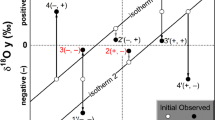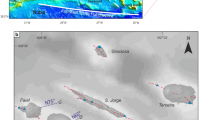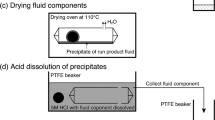Abstract
The estimation of the mobility of ancient groundwater provides clues to a number of fundamental and applied problems. The U(Th)-He system is a promising tool for dating ancient waters. This study focused on the recently proposed method of the reconstruction of helium concentration in groundwater. The method is based on equilibrium in the mineral-water system which allows us to avoid direct sampling of water from boreholes. Some minerals contain excess helium migrating from the ambient groundwater into the internal helium-accessible volume (HAV) of grains. For this study, quartz was sampled from the sandstones of the 1000-m-thick Permian-Carboniferous sedimentary sequence of the Molasse Basin in northern Switzerland. The HAV of the quartz concentrate was determined via helium saturation of samples under controlled conditions and subsequent helium analysis as 0.066 ± 0.037% of the bulk sample volume (hereafter, mean values for the sequence are given). The measurement of helium concentration in initial samples allowed us to determine the partial pressure of helium in the gas phase of HAV as 0.47 ± 0.16 atm; the concentration of helium in the pore water was calculated as the product of pressure and the Henry solubility constant corresponding to the conditions of natural rock occurrence: 0.0036 ± 0.0016 cm3 STP (He)/cm3 (H2O). This estimate based on mineral-water equilibrium is in good agreement with the results of direct measurements if helium content in water from the two aquifers of the Permian-Carboniferous sequence of the Molasse Basin, where helium concentrations were found to be 0.0045 and 0.0016 cm3 STP (He)/cm3 (H2O). The obtained results validated the method. A necessary prerequisite for its application is the equilibrium of helium concentrations in the water-HAV system. The investigation of helium mobility in quartz grains (through the measurement of helium release rates from the grains under isothermal heating at different temperatures) allowed us to estimate the time of equilibration as approximately 103 yr, which is much shorter than the helium residence time in the Permian-Carboniferous sequence of the basin (more than 107 yr). Using quartz grains as detectors of helium concentration in pore waters, it was shown that the waters of the whole sequence are stagnant, and the sequence is appropriate for the disposal of high-level radioactive wastes.
Similar content being viewed by others
References
B. A. Mamyrin and I. N. Tolstikhin, “Helium Isotopes in Nature,” in Developments in Geochemistry (Elsevier, Amsterdam, 1984), vol. 3.
V. P. Savchenko, “On Problem of Helium Geochemistry,” Prir. Gazy, No. 9, 53–108 (1935).
K. A. Farley, “(U-Th)/He Dating: Techniques, Calibrations, and Applications,” in Noble Gases in Geochemistry and Cosmochemistry, Rev. Mineral. Geochem. (Mineral. Soc. Am., Washington, 2002), vol. 47, pp. 819–844.
V. V. Ivanov, V. I. Medovy, and V. I. Dobrovol’skaya, “Fields of Helium Concentrations in Sedimentary Sequences,” Geol. Rev., 21(8), 891–903 (1978).
K. Osenbrück, J. Lippmann, and C. Sonntag, “Dating Very Old Porewaters in Impermeable Rocks by Noble Gas Isotopes,” Geochim. Cosmochim. Acta 62(18), 3041–3045 (1998).
A. P. Rübel, C. Sonntag, J. Lippmann, et al., “Solute Transport in Formations of Very Low Permeability: Profiles of Stable Isotopes and Noble Gas Content of Pore Water in the Opalinus Clay, Mont Terri, Switzerland,” Geochim. Cosmochim. Acta 66, 1311–1322 (2002).
B. Lehmann, N. Waber, I. Tolstikhin, et al., “Helium in Solubility Equilibrium with Quartz and Pore Fluids in Rocks: A New Approach in Hydrology,” Geophys. Res. Lett. 30(3), 1128 (2003).
I. N. Tolstikhin, B. E. Lehmann, H. H. Loosli, and A. Gautschi, “Helium and Argon Isotopes in Rocks, Minerals and Related Groundwaters: A Case Study in Northern Switzerland,” Geochim. Cosmochim. Acta 60, 1497–1514 (1996).
I. Tolstikhin, M. Gannibal, S. Tarakanov, et al., “Helium Transfer from Water into Quartz Crystals: A New Approach for Porewater Dating,” Earth Planet. Sci. Lett. 238, 31–41 (2005).
F. J. Pearson, W. Balderer, H. H. Loosli, et al., Applied Isotope Hydrogeology. A Case Study in Northern Switzerland (Elsevier, Amsterdam, 1991).
A. Jambon and J. Shelby, “Helium Diffusion and Solubility in Obsidians and Basaltic Glass in the Range 200–300°C,” Earth Planet. Sci. Lett. 51, 206–214 (1980).
C. L. Broadhurst, M. J. Drake, B. E. Hagee, and T. J. Bernatowicz, “Solubility and Partitioning of Ne, Ar, Kr, and Xe in Minerals and Synthetic Basaltic Melts,” Geochim. Cosmochim. Acta 56, 709–723 (1992).
S. V. Ikorskii, I. L. Kamenskii, B. Z. Pevzner, and M. A. Gannibal, “Experimental Modeling of Helium Migration into Natural Quartz Crystals,” Dokl. Earth Sci. 389A, 413–415 (2003).
R. F. Weiss, “Solubility of Helium and Neon in Water and Seawater,” J. Chem. Eng. Data 16(2), 235–241 (1971).
T. W. Trull, M. D. Kurz, and W. J. Jenkins, “Diffusion of Cosmogenic 3He in Olivine and Quartz: Implications for Surface Exposure Dating,” Earth Planet. Sci. Lett. 101, 241–256 (1991).
Author information
Authors and Affiliations
Corresponding author
Additional information
Original Russian Text © M.A. Gannibal, 2012, published in Geokhimiya, 2012, Vol. 50, No. 1, pp. 10–20.
Rights and permissions
About this article
Cite this article
Gannibal, M.A. Equilibrium helium partitioning in the rock-water system: New prospects for dating ancient groundwater. Geochem. Int. 50, 8–17 (2012). https://doi.org/10.1134/S001670291201003X
Received:
Accepted:
Published:
Issue Date:
DOI: https://doi.org/10.1134/S001670291201003X




